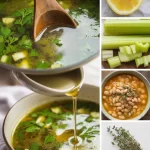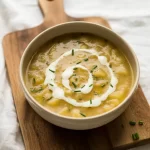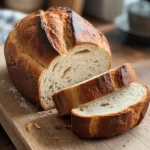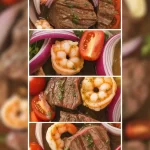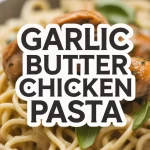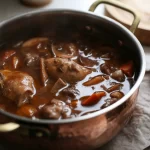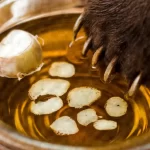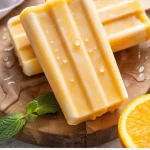I developed a sauce for roast duck that pairs pan-seared duck breast with fresh orange and hides a single surprising ingredient.

I love how this Duck Breast With Orange Sauce feels like a restaurant dish but doesn’t make you sweat. The contrast of duck breasts skin on and bright fresh orange juice creates a bold balance that surprises people.
Guests always lean in when I serve it curious if it’s complicated, they expect a secret but really its clever timing more than fuss. There’s a little show and quiet confidence to it that I’m proud of, and somehow it tastes like you spent hours.
Call it Duck Breast Orange and watch forks disappear fast.
Ingredients

- Duck breast rich in protein and iron, crispy skin adds savory texture.
- Orange juice bright citrus, vitamin C, adds sweet acid brightness and balances fat.
- Orange zest concentrated citrus oils, fragrant, gives zippy aroma without extra sugar.
- Marmalade or honey gives sweet body and glossy glaze, helps the sauce thicken slightly.
- Shallot mild onion flavor adds subtle sweetness and depth to the sauce.
- Chicken or duck stock adds savory backbone, deepens flavors and rounds citrus edges.
- Unsalted butter adds silkiness, glossy finish and richer mouthfeel.
Ingredient Quantities
- 2 duck breasts skin on about 6 to 8 oz (180 to 225 g) each
- Salt and freshly ground black pepper to taste
- 1 small shallot finely chopped
- 1 clove garlic minced optional
- 1 cup fresh orange juice about 240 ml from 2 to 3 oranges
- Zest of 1 orange
- 2 tbsp orange marmalade or 1 tbsp honey if you dont have marmalade
- 1 tbsp white wine vinegar
- 1/2 cup chicken or duck stock about 120 ml
- 2 tbsp Grand Marnier or Cointreau optional but nice
- 2 tbsp unsalted butter cold and cubed
- 1 tsp neutral oil for searing optional
How to Make this
1. Pat the duck breasts dry, score the skin in a crosshatch without cutting the meat, season both sides with salt and freshly ground black pepper.
2. Heat a cold heavy skillet over medium, add the duck breasts skin side down (no oil first, the skin will render its own fat); press them flat for even contact. If your pan is sticky, add the 1 tsp neutral oil only after it’s hot.
3. Slowly render the fat about 8 to 12 minutes until the skin is deep golden and crisp and most fat is rendered; spoon off and reserve excess fat into a jar for another use as you go. If the pan smokes, turn heat down.
4. Flip the breasts and cook flesh side 3 to 5 minutes until browned. For medium rare aim for an internal temp of about 135°F (57°C). If needed, finish in a 400°F (200°C) oven 5 to 8 minutes depending on thickness. Rest the duck 5 to 10 minutes tented while you make the sauce.
5. Pour off all but about 1 tablespoon of the duck fat from the pan, return to medium heat and add the finely chopped shallot (and the minced garlic if using). Sauté about 1 to 2 minutes until translucent, don’t let it burn.
6. Add 1 tbsp white wine vinegar to deglaze the pan, scraping up browned bits, then pour in 1 cup fresh orange juice and the orange zest. Add 2 tbsp orange marmalade (or 1 tbsp honey if no marmalade) and 1/2 cup chicken or duck stock.
7. Bring to a simmer and reduce gently until syrupy and slightly thickened, about 6 to 10 minutes. Taste and season with salt and pepper. If using, stir in 2 tbsp Grand Marnier or Cointreau and simmer 30 seconds to blend.
8. Off the heat, whisk in the 2 tbsp cold cubed unsalted butter a piece at a time to emulsify and give the sauce a glossy finish. If sauce is too thick, add a splash more stock or orange juice; too thin, reduce a little more.
9. Slice the rested duck breasts against the grain, arrange on plates and spoon the orange sauce over. Any leftover pan juices mixed into the sauce are great. Serve immediately.
Equipment Needed
1. Ovenproof heavy skillet or cast iron skillet (large enough for 2 breasts)
2. Sharp chef’s knife
3. Cutting board
4. Long tongs for flipping and pressing
5. Instant read meat thermometer (target about 135°F / 57°C for medium rare)
6. Heatproof spatula or wooden spoon for deglazing and scraping
7. Measuring cups and spoons
8. Microplane or zester for the orange
9. Small heatproof jar or bowl and a spoon to save and skim the duck fat
10. Aluminum foil to tent the rested duck
FAQ
Duck Breast With Orange Sauce Recipe Substitutions and Variations
- Fresh orange juice: if you dont have oranges use tangerine or blood orange juice 1:1 for a very similar bright flavor; for a tangier twist swap in 3/4 cup pomegranate or cranberry juice but cut back on any added sweetener.
- Orange marmalade or honey: swap with apricot or peach jam 1:1 for the same sticky-sweet glaze, or use 1 tbsp maple syrup for a deeper, less citrusy sweetness.
- Grand Marnier or Cointreau: replace with 2 tbsp triple sec or 1 tbsp brandy or cognac for boozy depth; or omit and stir in extra orange zest and a splash of stock to keep the sauce balanced.
- Chicken or duck stock: use low-sodium chicken broth or vegetable stock 1:1, or dissolve 1 tsp bouillon in 1/2 cup hot water if thats what you got on hand.
Pro Tips
1) Let the duck sit out about 20 to 30 minutes before you cook it, dont put a cold breast straight in a hot pan. It helps the meat cook more evenly and stops the skin from puckering.
2) Render the fat low and slow, and keep a spoon handy to remove excess as it builds up. Save that fat in a jar, its awesome for frying potatoes or veg later and will pay back the effort tenfold.
3) Finish the sauce off the heat with cold butter, add it one small cube at a time while whisking so it emulsifies and gets glossy; if it breaks, a splash of stock or orange juice and more whisking will usually bring it back. Taste as you go and tweak sweetness or vinegar, dont rely only on the recipe amounts.
4) Rest the breasts at least 5 minutes, then slice thinly against the grain and pour the warm sauce over just before serving. If you need to finish in the oven, pull them a few degrees under your target temp because carryover will get you to perfect doneness.

Duck Breast With Orange Sauce Recipe
I developed a sauce for roast duck that pairs pan-seared duck breast with fresh orange and hides a single surprising ingredient.
2
servings
950
kcal
Equipment: 1. Ovenproof heavy skillet or cast iron skillet (large enough for 2 breasts)
2. Sharp chef’s knife
3. Cutting board
4. Long tongs for flipping and pressing
5. Instant read meat thermometer (target about 135°F / 57°C for medium rare)
6. Heatproof spatula or wooden spoon for deglazing and scraping
7. Measuring cups and spoons
8. Microplane or zester for the orange
9. Small heatproof jar or bowl and a spoon to save and skim the duck fat
10. Aluminum foil to tent the rested duck
Ingredients
-
2 duck breasts skin on about 6 to 8 oz (180 to 225 g) each
-
Salt and freshly ground black pepper to taste
-
1 small shallot finely chopped
-
1 clove garlic minced optional
-
1 cup fresh orange juice about 240 ml from 2 to 3 oranges
-
Zest of 1 orange
-
2 tbsp orange marmalade or 1 tbsp honey if you dont have marmalade
-
1 tbsp white wine vinegar
-
1/2 cup chicken or duck stock about 120 ml
-
2 tbsp Grand Marnier or Cointreau optional but nice
-
2 tbsp unsalted butter cold and cubed
-
1 tsp neutral oil for searing optional
Directions
- Pat the duck breasts dry, score the skin in a crosshatch without cutting the meat, season both sides with salt and freshly ground black pepper.
- Heat a cold heavy skillet over medium, add the duck breasts skin side down (no oil first, the skin will render its own fat); press them flat for even contact. If your pan is sticky, add the 1 tsp neutral oil only after it’s hot.
- Slowly render the fat about 8 to 12 minutes until the skin is deep golden and crisp and most fat is rendered; spoon off and reserve excess fat into a jar for another use as you go. If the pan smokes, turn heat down.
- Flip the breasts and cook flesh side 3 to 5 minutes until browned. For medium rare aim for an internal temp of about 135°F (57°C). If needed, finish in a 400°F (200°C) oven 5 to 8 minutes depending on thickness. Rest the duck 5 to 10 minutes tented while you make the sauce.
- Pour off all but about 1 tablespoon of the duck fat from the pan, return to medium heat and add the finely chopped shallot (and the minced garlic if using). Sauté about 1 to 2 minutes until translucent, don’t let it burn.
- Add 1 tbsp white wine vinegar to deglaze the pan, scraping up browned bits, then pour in 1 cup fresh orange juice and the orange zest. Add 2 tbsp orange marmalade (or 1 tbsp honey if no marmalade) and 1/2 cup chicken or duck stock.
- Bring to a simmer and reduce gently until syrupy and slightly thickened, about 6 to 10 minutes. Taste and season with salt and pepper. If using, stir in 2 tbsp Grand Marnier or Cointreau and simmer 30 seconds to blend.
- Off the heat, whisk in the 2 tbsp cold cubed unsalted butter a piece at a time to emulsify and give the sauce a glossy finish. If sauce is too thick, add a splash more stock or orange juice; too thin, reduce a little more.
- Slice the rested duck breasts against the grain, arrange on plates and spoon the orange sauce over. Any leftover pan juices mixed into the sauce are great. Serve immediately.
Notes
- Below you’ll find my best estimate of this recipe’s nutrition facts. Treat the numbers as a guide rather than a rule—great food should nourish both body and spirit. Figures are approximate, and the website owner assumes no liability for any inaccuracies in this recipe.
Nutrition Facts
- Serving Size: 300g
- Total number of serves: 2
- Calories: 950kcal
- Fat: 72g
- Saturated Fat: 27g
- Trans Fat: 0.5g
- Polyunsaturated: 6g
- Monounsaturated: 36g
- Cholesterol: 150mg
- Sodium: 550mg
- Potassium: 700mg
- Carbohydrates: 26g
- Fiber: 1g
- Sugar: 20g
- Protein: 46g
- Vitamin A: 250IU
- Vitamin C: 35mg
- Calcium: 30mg
- Iron: 5.4mg





